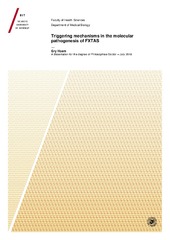Is a modified Global Trigger Tool method using automatic trigger identification valid when measuring adverse events? A comparison of review methods using automatic and manual trigger identification
Permanent lenke
https://hdl.handle.net/10037/15255Dato
2018-10-08Type
Journal articleTidsskriftartikkel
Peer reviewed
Forfatter
Mevik, Kjersti; Hansen, Tonje Elisabeth; Deilkås, Ellen C Tveter; Ringdal, Alexander; Vonen, BartholdSammendrag
Objectives - To evaluate a modified Global Trigger Tool (GTT) method with manual review of automatic triggered records to measure adverse events.
Design - A cross-sectional study was performed using the original GTT method as gold standard compared to a modified GTT method.
Setting - Medium size hospital trust in Northern Norway.
Participants - One thousand two hundred thirty-three records selected between March and December 2013.
Main outcome measure - Records with triggers, adverse events and number of adverse events identified. Recall (sensitivity), precision (positive predictive value), specificity and Cohen’s kappa with 95 % confidence interval were calculated.
Results - Both methods identified 35 adverse events per 1000 patient days. The modified GTT method with manual review of 658 automatic triggered records identified adverse events (n = 214) in 189 records and the original GTT method identified adverse events (n = 216) in 186 records. One hundred and ten identical records were identified with adverse events by both methods. Recall, precision, specificity and reliability for records identified with adverse events were respectively 0.59, 0.58, 0.92 and 0.51 for the modified GTT method. The total manual review time in the modified GTT method was 23 h while the manual review time using the original GTT method was 411 h.
Conclusions - The modified GTT method is as good as the original GTT method that complies with the GTTs aim monitoring the rate of adverse events. Resources saved by using the modified GTT method enable for increasing the sample size. The automatic trigger identification system may be developed to assess triggers in real-time to mitigate risk of adverse events.
Beskrivelse
Er en del av
Mevik, K. (2019). Identifying and measuring patient harms. A study of measuring adverse events in hospitalised patients by the Global Trigger Tool record review method. (Doctoral thesis). https://hdl.handle.net/10037/15257Forlag
Oxford University PressSitering
Mevik, K., Hansen, T.E., Deilkås, E.C., Ringdal, A.M. & Vonen, B. (2018). Is a modified Global Trigger Tool method using automatic trigger identification valid when measuring adverse events? A comparison of review methods using automatic and manual trigger identification. International Journal for Quality in Health Care, mzy210. https://doi.org/10.1093/intqhc/mzy210Metadata
Vis full innførselSamlinger
Relaterte innførsler
Viser innførsler relatert til tittel, forfatter og emneord.
-
Acute infection as a trigger for incident venous thromboembolism: Results from a population- based case- crossover study
Grimnes, Gro; Isaksen, Trond; Tichelaar, Ynse Ieuwe Gerardus Vladimir; Brækkan, Sigrid Kufaas; Hansen, John-Bjarne (Journal article; Tidsskriftartikkel; Peer reviewed, 2017-12-21)Background:<br> A bidirectional relation exists between acute infection and immobilization, and both are triggers for venous thromboembolism (VTE). To what extent the association between infection and VTE‐risk is explained by immobilization is unknown. <br>Aims:<br> To investigate the impact of hospitalization with acute infection on the VTE‐risk in patients with and without concomitant ... -
Glacigenic sedimentation pulses triggered postglacial gas hydrate dissociation
Karstens, Jens; Haflidason, Haflidi; Becker, Lukas W.M.; Berndt, Christian; Rüpke, Lars; Planke, Sverre; Liebetrau, Volker; Schmidt, Markus; Mienert, Jürgen (Journal article; Tidsskriftartikkel; Peer reviewed, 2018-02-12)Large amounts of methane are stored in continental margins as gas hydrates. They are stable under high pressure and low, but react sensitively to environmental changes. Bottom water temperature and sea level changes were considered as main contributors to gas hydrate dynamics after the last glaciation. However, here we show with numerical simulations that pulses of increased sedimentation dominantly ... -
Triggering mechanisms in the molecular pathogenesis of FXTAS
Hoem, Gry (Doctoral thesis; Doktorgradsavhandling, 2018-10-31)This study focuses on the triggering mechanisms leading to development of the neurodegenerative disorder Fragile X-associated tremor/ataxia syndrome (FXTAS). FXTAS affects carriers of a “premutation” in the Fragile X Mental Retardation 1 (FMR1) gene on the X chromosome. A premutation in this context, means the presence of 55-200 CGG repeats in the 5’untranslated region of the gene. Unaffected ...


 English
English norsk
norsk


